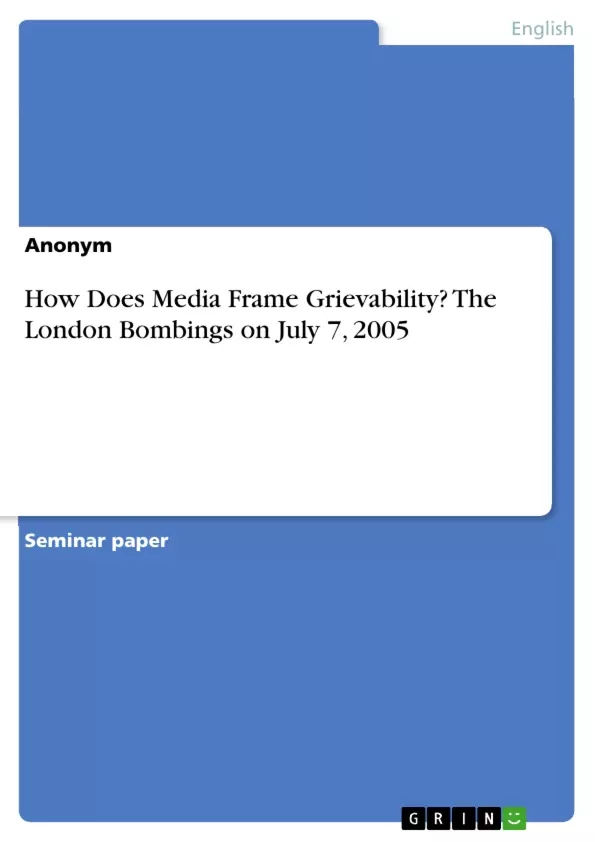Based on the understanding of media as a powerful institution that substantially affects our notion of happenings around us, this paper looks into the highly significant impacts of media on the human thinking and behavior in regard to whom and how we mourn. In particular, the aim of this paper is to demonstrate the constructed differentiation between "grievable" and "ungrievable" lives in mass media coverage following the terrorist attacks on July 7, 2005, in London.
Media has undeniably taken a highly important role in today’s rapidly changing and globally networked world. It allows for a fast exchange of information, worldwide interconnection as well as a deeper human connection. However, regardless of the beneficial functions media fulfills, it is also important to consider the significant impact media has on shaping public opinions as well as the perception of reality. Especially news media has an immense influence on the construction of widely spread concepts and ideas, as they reach a large audience and are (mostly) considered a reliable source of information. Therefore, it seems all the more important to critically reflect upon the medially conveyed thoughts and images, and the associated implications on society.
Drawing on Judith Butler’s works Precarious Life and Frames of War, the notion of grievability and the culturally determined framing of humanness are discussed at first. Thus, this paper depicts the global divide between lives that are considered "human" and, therefore, grievable, and those that do not conform to what is regarded as "human" within a society and accordingly count as "ungrievable".
Subsequently, this paper analyzes the specific ways in which newspapers contribute to the construction of "grievable" and "ungrievable" life by looking at how the media report disastrous events such as the suicide bombings in London on July 7, 2005. Drawing on the proposed analytical framework by Tal Morse, this paper systematically examines the precise ways in which the media representation of the London bombings had a significant influence on the construction of ‘grievable’ and ‘non-grievable’ lives and the act of public mourning. However, due to limited space, this paper focuses only on UK newspapers that have national coverage and investigates reports of the London bombings in selected media, which are considered representative for the extensive reporting of this terror attack.
Inhaltsverzeichnis (Table of Contents)
- INTRODUCTION
- GRIEVABLE AND UNGRIEVABLE LIFE
- Humanness as a cultural construct
- Public mourning
- ANALYSIS OF SELECTED UK NEWSPAPERS
- The Guardian
- Reconstruction of (in)humanness of the dead
- Construction of shared time and place
- Production of a witnessable account
- The Daily Mail
- Reconstruction of (in)humanness of the dead
- Construction of shared time and place
- Production of a witnessable account
- The,press rite' of media coverage
- The Guardian
- CONCLUSION
Zielsetzung und Themenschwerpunkte (Objectives and Key Themes)
This paper explores the construction of “grievable” and “ungrievable” lives in media coverage of the 2005 London bombings, drawing on Judith Butler's theories of grievability and cultural framing. The primary objective is to demonstrate how media representations contribute to the differentiation between lives deemed worthy of mourning and those that are disregarded. Key themes include:- The cultural construction of humanness and its impact on who is considered grievable.
- The role of media in shaping public opinion and perceptions of reality, particularly in relation to events like terrorist attacks.
- The impact of cultural and religious differences on the perception of otherness and the construction of “us” versus “them” narratives.
- The analysis of media framing techniques, specifically examining how newspapers reconstruct the “humanness” of the dead, construct shared time and place, and produce witnessable accounts.
- The ethical implications of media representation in relation to the recognition of loss and the act of public mourning.
Zusammenfassung der Kapitel (Chapter Summaries)
- Introduction: This chapter sets the context by highlighting the significance of media in shaping public perceptions and underscores the need to critically analyze media representations. It introduces the paper's focus on the constructed differentiation between “grievable” and “ungrievable” lives in the context of the 2005 London bombings, drawing on Judith Butler's theories.
- Grievable and Ungrievable Life: This chapter delves into the concept of grievability, as proposed by Judith Butler. It examines the culturally determined framing of humanness and explores the distinction between lives deemed worthy of mourning and those that are not recognized as “human” and therefore, “ungrievable.” The chapter highlights the impact of cultural frames on the ability to acknowledge loss.
- Humanness as a Cultural Construct: This chapter elaborates on the consequences of differentiating between “human” and “inhuman” lives, particularly in a multicultural world. It addresses the rise of inhuman ideologies and the impact of stereotypes on perceptions of otherness. The chapter explores how social norms and values shape the perception of individuals as “precious” or “unimportant,” leading to a global divide in the recognition of loss.
Schlüsselwörter (Keywords)
The primary keywords and focus topics include grievability, ungrievability, media framing, cultural framing, humanness, otherness, public mourning, 2005 London bombings, Judith Butler, Tal Morse, UK newspapers, The Guardian, The Daily Mail. These terms encapsulate the central themes and concepts investigated in this paper, particularly the impact of media representations on the perception of “grievable” and “ungrievable” lives.- Arbeit zitieren
- Anonym (Autor:in), 2018, How Does Media Frame Grievability? The London Bombings on July 7, 2005, München, GRIN Verlag, https://www.hausarbeiten.de/document/509917


